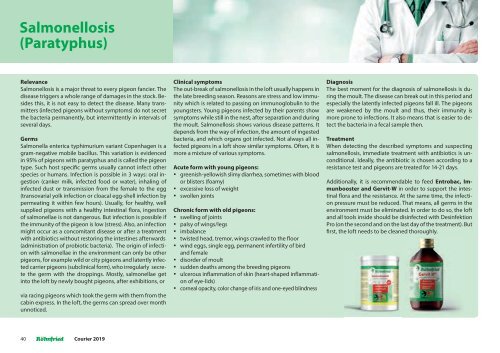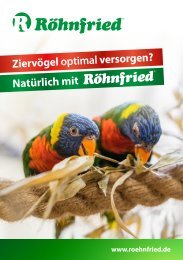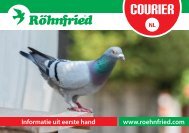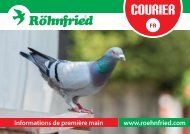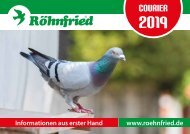Röhnfried Courier 2019 English
You also want an ePaper? Increase the reach of your titles
YUMPU automatically turns print PDFs into web optimized ePapers that Google loves.
Salmonellosis<br />
(Paratyphus)<br />
Relevance<br />
Salmonellosis is a major threat to every pigeon fancier. The<br />
disease triggers a whole range of damages in the stock. Besides<br />
this, it is not easy to detect the disease. Many transmitters<br />
(infected pigeons without symptoms) do not secret<br />
the bacteria permanently, but intermittently in intervals of<br />
several days.<br />
Germs<br />
Salmonella enterica typhimurium variant Copenhagen is a<br />
gram-negative mobile bacillus. This variation is evidenced<br />
in 95% of pigeons with paratyphus and is called the pigeon<br />
type. Such host specific germs usually cannot infect other<br />
species or humans. Infection is possible in 3 ways: oral ingestion<br />
(canker milk, infected food or water), inhaling of<br />
infected dust or transmission from the female to the egg<br />
(transovarial yolk infection or cloacal egg-shell infection by<br />
permeating it within few hours). Usually, for healthy, well<br />
supplied pigeons with a healthy intestinal flora, ingestion<br />
of salmonellae is not dangerous. But infection is possible if<br />
the immunity of the pigeon is low (stress). Also, an infection<br />
might occur as a concomitant disease or after a treatment<br />
with antibiotics without restoring the intestines afterwards<br />
(administration of probiotic bacteria). The origin of infection<br />
with salmonellae in the environment can only be other<br />
pigeons, for example wild or city pigeons and latently infected<br />
carrier pigeons (subclinical form), who irregularly secrete<br />
the germ with the droppings. Mostly, salmonellae get<br />
into the loft by newly bought pigeons, after exhibitions, or<br />
via racing pigeons which took the germ with them from the<br />
cabin express. In the loft, the germs can spread over month<br />
unnoticed.<br />
Clinical symptoms<br />
The out-break of salmonellosis in the loft usually happens in<br />
the late breeding season. Reasons are stress and low immunity<br />
which is related to passing on immunoglobulin to the<br />
youngsters. Young pigeons infected by their parents show<br />
symptoms while still in the nest, after separation and during<br />
the moult. Salmonellosis shows various disease patterns. It<br />
depends from the way of infection, the amount of ingested<br />
bacteria, and which organs got infected. Not always all infected<br />
pigeons in a loft show similar symptoms. Often, it is<br />
more a mixture of various symptoms.<br />
Acute form with young pigeons:<br />
• greenish-yellowish slimy diarrhea, sometimes with blood<br />
or blisters (foamy)<br />
• excessive loss of weight<br />
• swollen joints<br />
Chronic form with old pigeons:<br />
• swelling of joints<br />
• palsy of wings/legs<br />
• imbalance<br />
• twisted head, tremor, wings crawled to the floor<br />
• wind eggs, single egg, permanent infertility of bird<br />
and female<br />
• disorder of moult<br />
• sudden deaths among the breeding pigeons<br />
• ulcerous inflammation of skin (heart-shaped inflammation<br />
of eye-lids)<br />
• corneal opacity, color change of iris and one-eyed blindness<br />
Diagnosis<br />
The best moment for the diagnosis of salmonellosis is during<br />
the moult. The disease can break out in this period and<br />
especially the latently infected pigeons fall ill. The pigeons<br />
are weakened by the moult and thus, their immunity is<br />
more prone to infections. It also means that is easier to detect<br />
the bacteria in a fecal sample then.<br />
Treatment<br />
When detecting the described symptoms and suspecting<br />
salmonellosis, immediate treatment with antibiotics is unconditional.<br />
Ideally, the antibiotic is chosen according to a<br />
resistance test and pigeons are treated for 14-21 days.<br />
Additionally, it is recommendable to feed Entrobac, Immunbooster<br />
and Gervit-W in order to support the intestinal<br />
flora and the resistance. At the same time, the infection<br />
pressure must be reduced. That means, all germs in the<br />
environment must be eliminated. In order to do so, the loft<br />
and all tools inside should be disinfected with Desinfektion<br />
Pro (on the second and on the last day of the treatment). But<br />
first, the loft needs to be cleaned thoroughly.<br />
40 <strong>Courier</strong> <strong>2019</strong>


